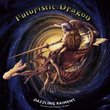| All Artists: Walter Gieseking, Robert Schumann, Domenico Scarlatti, Johann Sebastian Bach, Wolfgang Amadeus Mozart Title: Walter Gieseking: Private and archival recordings. 1924-45 Members Wishing: 0 Total Copies: 0 Label: Arbiter Release Date: 3/15/2000 Album Type: Import Genres: Special Interest, Classical Styles: Chamber Music, Forms & Genres, Sonatas, Historical Periods, Baroque (c.1600-1750), Classical (c.1770-1830), Romantic (c.1820-1910) Number of Discs: 1 SwapaCD Credits: 1 UPCs: 675754164621, 604907012229 |
Search - Walter Gieseking, Robert Schumann, Domenico Scarlatti :: Walter Gieseking: Private and archival recordings. 1924-45
 | Walter Gieseking, Robert Schumann, Domenico Scarlatti Walter Gieseking: Private and archival recordings. 1924-45 Genres: Special Interest, Classical
The early Gieseking was quite a different pianist from the refined colorist familiar from his often perfunctory postwar EMI recordings. This important release includes examples of the great pianist's recordings and broadca... more » |
Larger Image |
CD Details
Synopsis
Amazon.com
The early Gieseking was quite a different pianist from the refined colorist familiar from his often perfunctory postwar EMI recordings. This important release includes examples of the great pianist's recordings and broadcasts made between 1924 and 1945. We hear a more engaged and vigorous artist here, evidenced by the energetic snap in the Schubert Sonata and the sweep and power of Schumann's Études Symphoniques. Both are from a broadcast made in the closing weeks of the war, which could account for some of the uncharacteristic intensity. The Baroque items, taken from unpublished 1924-1925 pressings, offer playing of consummate elegance. The 1940 Mozart sonata is more lively and pointed than the postwar remake. Schumann's Kinderszenen, also from 1940 and the only previously available item here, flows with warm tone and touching delicacy. Sound throughout is good for the period and source. --Dan Davis

 Track Listings (36) - Disc #1
Track Listings (36) - Disc #1

